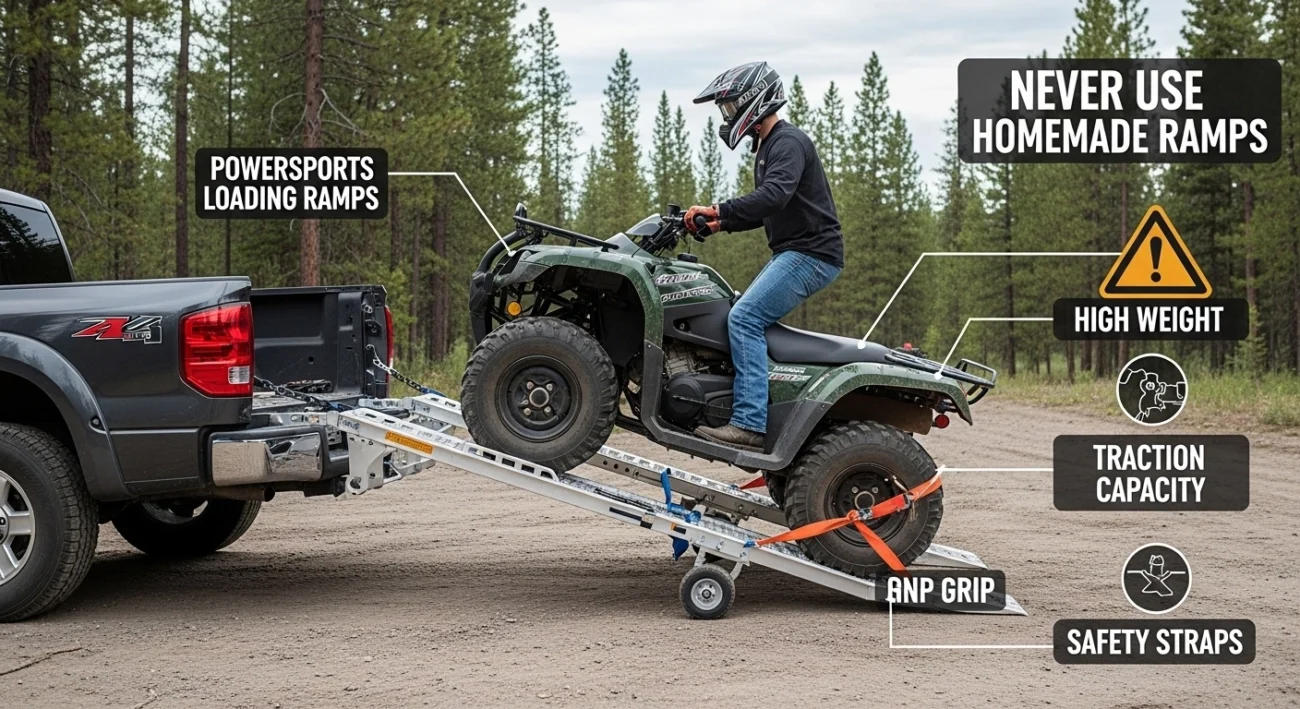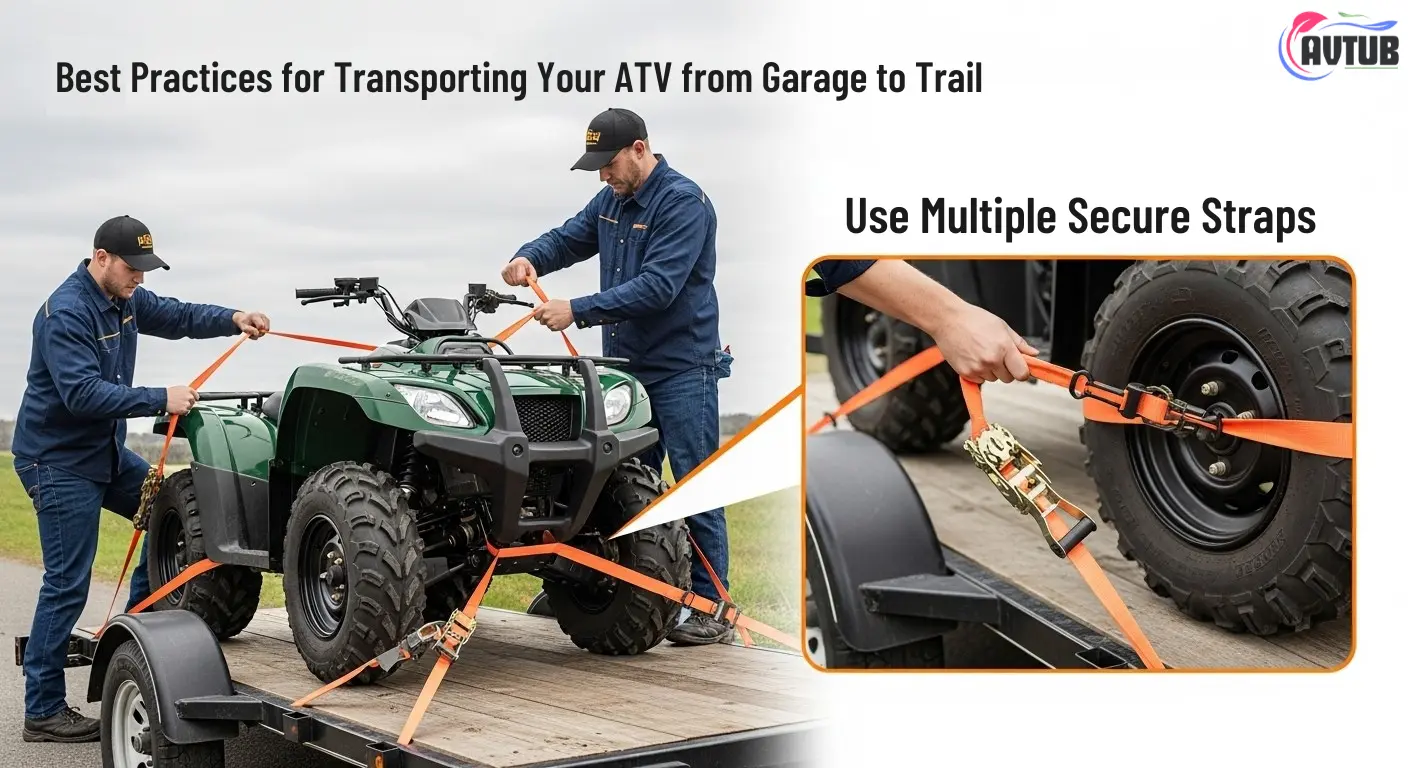Transporting an All-Terrain Vehicle (ATV) safely requires proper preparation, equipment, and technique to prevent damage and accidents. Whether using a truck bed or a trailer, key practices include verifying that your hauling vehicle can handle the combined weight, using high-quality ratchet straps with sufficient load capacity, and securing the ATV to its frame at all four corners. Ensure ramps are properly rated and secured for safe loading and unloading. On the road, drive cautiously, perform regular checks of the tie-downs, and account for the extra weight affecting braking and maneuvering. These steps minimize risks and ensure your ATV arrives at its destination ready for the trail.
Choose the Right Transport Method
The first step is deciding how you’ll move your ATV. Most riders transport their vehicles using either a pickup truck or a trailer.
Pickup Truck:
If you have a standard truck bed, you may be able to load the ATV directly. Make sure to verify dimensions both width and length to confirm that your ATV fits. Truck beds offer convenience, but loading can be tricky without a proper ramp.
Trailer:
Trailers offer excellent space and stability, making them a smart choice when hauling multiple ATVs or heavier models. Utility trailers with built-in ramps make loading simple and efficient, while choosing an enclosed trailer in Utah adds extra protection from weather, dust, and road debris keeping your ATV secure throughout the trip.
No matter which method you choose, ensure the vehicle or trailer is rated to handle the ATV’s weight. Overloading can lead to unsafe driving conditions and mechanical damage.
Use a Stable Loading Ramp

Never attempt to drive or push your ATV into a truck bed or trailer without a ramp specifically designed for powersports equipment. Homemade planks or makeshift ramps can shift, break, or slide, leading to serious injury and damage.
Look for a ramp with:
- A high weight capacity
- Grip or traction features
- Safety straps to secure it to the trailer or truck
When loading, ensure the ramp is firmly in place, and the ground is level. If possible, load from a slight incline or use a loading dock to reduce the angle of ascent. Take it slow and steady no sudden acceleration.
Secure the ATV Properly
Once your ATV is loaded, the next step is keeping it in place. Tie-down straps are your best friend here. Avoid using rope or bungee cords they don’t have the tension or durability needed for safe hauls.
Here’s a foolproof tie-down method:
- Attach ratchet straps to four anchor points two in the front and two in the rear.
- Compression is key. Use the straps to slightly compress the ATV’s suspension. This prevents bounce and shifting during transport.
- Check attachment points. Hook straps to solid, welded points on the frame not the handlebars or racks, which can bend.
Before pulling away, give the ATV a firm shake. If it shifts or loosens, tighten the straps.
Distribute Weight Properly
Good weight distribution ensures the transport vehicle handles well. When loading a trailer:
- Position the ATV so 60% of the weight loss sits toward the front of the trailer.
- Ensure the tongue weight (the downward force on the hitch) is correct. Too little weight at the hitch can cause trailer sway; too much can damage your vehicle’s suspension.
If transporting multiple ATVs, place the heavier one at the front.
Prepare Your ATV for Transport
Just as you prepare a vehicle before a road trip, your ATV needs some pre-transport attention.
- Remove loose items. Anything in the cargo racks should be stowed or taken off.
- Turn off the fuel valve and disconnect the battery if transporting long-distance.
- Check tire pressure proper inflation improves stability and reduces bounce.
A quick cleaning also helps. Mud or debris can fall during transit, causing hazards on the road.
Drive Safely and Stay Vigilant
Once everything is loaded and secured, it’s time to hit the road but gently. Accelerate slowly and take turns wider than usual, especially when towing a trailer. Give yourself additional braking distance, and avoid sudden stops when possible.
It’s also smart to pull over occasionally during the trip to inspect your tie-downs and ensure nothing has shifted. Wind, road bumps, and vibration can loosen straps over time.
Unloading with Caution
Unloading follows the same principles as loading slow and controlled. Make sure the ramp is secure and that the area behind the trailer or truck is clear. Release tie downs in a staggered fashion to avoid sudden shifts when the suspension decompresses.
Final Thoughts
Transporting your ATV shouldn’t be intimidating. With the right equipment and some careful preparation, you can move your vehicle from your garage to the trail smoothly and safely. Choose a secure loading method, use reliable tie-downs, check your weight distribution, and drive with awareness. Your adventure begins long before you reach the trail make the journey just as safe and enjoyable as the destination.


